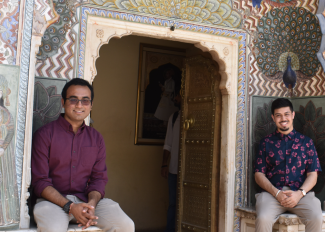
Santosh Nori is a junior in Penn's College of Arts and Sciences majoring in Biology. He also volunteers at the United Community Clinic operated by Penn Medicine. This summer, Santosh was able to travel to Jaipur, India to work with the Indian Institute of Health Management Research (IIHMR), which is directed by Penn Alum Dr. Vivek Bhandari. Learn more about Santosh's experience below.
"As my airplane started to descend to the city of Jaipur, I started to feel queasy with the mix of nervousness and excitement that comes with visiting a new place. Looking down from my airplane window, I was thrilled to see the unfamiliar environment that I would call home for two months, and couldn’t help but consider myself lucky to be able to leave campus and spend my summer in another country.
This summer, I worked with the Indian Institute of Health Management Research (IIHMR) in Jaipur, India. IIHMR is a research and educational institute devoted to investigating and solving public health issues all around India. It functions as a WHO Collaborating Center for District Health Systems Based on Primary Healthcare, and closely works with the Government of India, the World Health Organization, reputed universities from around the world such as Penn and Johns Hopkins, and foreign governments. The institute trains students and professionals in different dimensions of public health and healthcare delivery, in an effort to improve the quality of healthcare systems in India and the rest of South Asia. As a student passionate about global health, I was elated to receive an opportunity to work with IIHMR.
During my stay in Jaipur, I designed and conducted a research project to assess the health expenditure of patients attending government health facilities for non-communicable disease (NCD) treatment. During the first week of my internship, I met with the reputed faculty of the Institute to learn more about the projects they were conducting. I was very interested in studying healthcare delivery to the poor in India, and when I expressed this to the faculty, they were very open to my ideas and interests. They suggested I design my own research project from scratch and offered their support in this process. I started to work with Dr. Mohan Bairwa, a professor at the institute interested in epidemiology and healthcare delivery, to design my project.
For the first couple of weeks, I was exposed to a lot of books and articles about India’s government, history, and healthcare system. As a foreigner in the country, I had no clue how the country’s healthcare system worked, so learning about the intricacies of how India’s people received healthcare was the first priority. After looking at the history of India’s government and the most recent research about public health in India, I was able to come up with a plan and design for my study. By choosing to assess levels of health expenditure, I wanted to see whether the healthcare policies that I had learned about in my reading, particularly those under India’s National Health Mission (NHM), were actually effective in helping the poor afford treatment.
As part of my project, I travelled to villages outside Jaipur, and interviewed patients, doctors, and health workers at clinics and hospitals where I collected data about patients’ health expenditure, medical history, and demographics. Seeing these clinics was eye opening, as they were totally different from anything that exists in the US. Hundreds of people would crowd into a room over the course of a few hours, trying to speak to one doctor that treated all their problems. Patients with tuberculosis, chikungunya, malaria, and dengue would all be in the same room, potentially infecting one another and the doctor himself. Additionally, I met with government officials first hand to talk about my project, including the Medical Director of Rajasthan and Chief Medical and Health Officers (CMHOs) of the Jaipur district. They were very interested in seeing if they could use my results to learn about, and resolve, the problems in their healthcare system.
One of the main highlights of my trip was communicating with patients and doctors in Hindi, as many of them had weak English skills. I did not know the language very well before my trip, but I was able to pick it up rather quickly through the help of friends and mentors. Being able to interact with patients and learn about their lives and experiences was really amazing, and I learned a lot about the medical, financial, and personal problems these people faced.
Personally, I grew a lot from this international experience. I was able to witness how prevalent healthcare inequality really is, particularly in India and in South Asia as a whole. Being able to see both wealthy, urban settings and less developed, rural settings showed me that India and its condition cannot be generalized. My work exposed me to the realities and nuances of a developing India that both adapts to the globalizing world but still retains the positive and negative aspects of its history. I would strongly urge any future students of this program to take up projects that will allow them to see this dichotomy: either on an academic or personal level. I would highly recommend this program, as it gave me the freedom to study India in the context of my majors while still giving me all the experiences that would come with a foreign exchange and cultural program. Last but not least, I am grateful for having the opportunity to make some lifelong friends and see some amazing things in India. I am continuing to work on this project remotely to publish the results of my study, and I hope to visit Jaipur again someday!"
